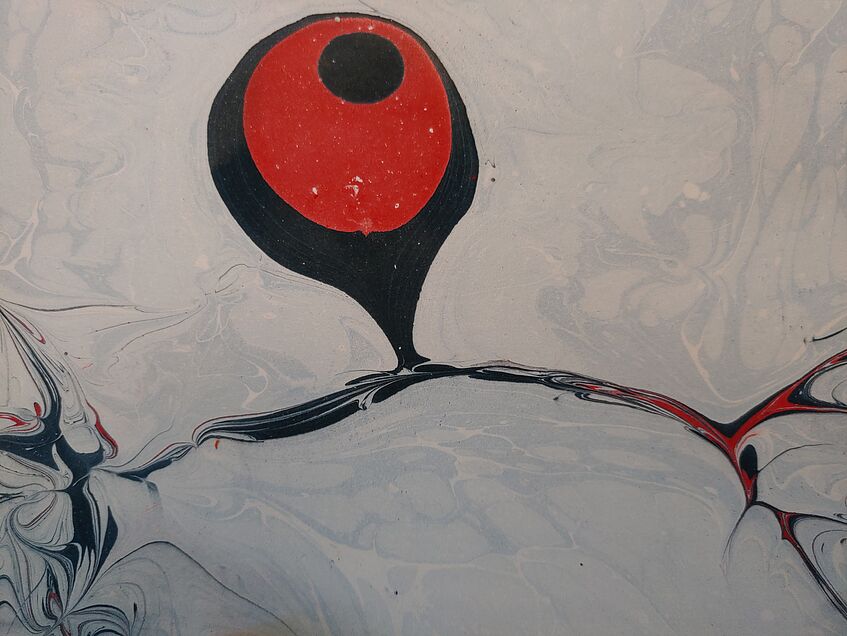Systems Biology of Pain
Head of Research Group: Univ. Prof. Manuela Schmidt

Artwork by Julia Regina Sondermann.
Mission statement
Research in our laboratory is driven by our motivation to decipher the dynamics of protein networks underlying vertebrate somatosensation in health, development (aging) and disease (chronic pain). Methodologically, we combine molecular biology, biochemistry and latest proteomics techniques, electrophysiology, pharmacology, mouse models of painful pathologies and in vivo virus-mediated gene transfer.
This multidisciplinary approach has enabled us to reveal ion channel-associated signaling complexes (i.e. the interactome of TRPV1, TRPA1 and Piezo2 channels) with pathological relevance for pain. Moreover, in a quantitative systems biology approach, we investigate spatiotemporal proteome dynamics both in mice and humans. Our research lives from our fruitful collaborations with basic researchers and clinicians alike facilitating forward and reverse translation of our research results.
In this way we strive to gain mechanistic insights into developmental and pain-associated plasticity – an endeavor, which lies at the heart of both understanding the molecular signature of chronic pain and identifying novel drug targets.
Team
- Univ. Prof. Manuela Schmidt, PhD. (Head of Research Group)
- Dr. David Gomez Varela (Senior Scientist)
- Lukas Uhrik, MSc. PhD(Postdoc)
- Feng Xian, PhD (Postdoc)
- Giacomo Carta, PhD (Postdoc)
- Nicole Kanta, BSc (TA)
- Ahmed Mohamed Mahmoud Hussein, BSc. MSc, PhD (TA)
- Peter Höflich (animal care facility)
- Natascha Deutsch (animal care facility)
- Ranjith Kumar Ravi Kumar PhD (Postdoc)
- Allisaon Barry MSc PhD (postdoc)
Selected recent publications
- Urbauer E, Aguanno D, Mindermann N, Omer H, Metwaly A, Krammel T, Faro T, Remke M, Reitmeier S, Bärthel S, Kersting J, Huang Z, Xian F, Schmidt M, Saur D, Huber S, Stecher B, List M, Gómez-Varela D, Steiger K, Allez M, Rath E, Haller D. Mitochondrial perturbation in the intestine causes microbiota-dependent injury and gene signatures discriminative of inflammatory disease. Cell Host Microbe. 2024 doi: 10.1016/j.chom.2024.06.013
- Segelcke D, van der Burgt M, Kappert C, Schmidt-Garcia D, Sondermann JR, Bigalke S, et al..Schmidt M*, Esther M. Pogatzki-Zahn* (2023). Phenotype- and species-specific skin proteomic signatures for incision-induced pain in humans and mice. British Journal of Anaesthesia (BJA); doi: 10.1016/j.bja.2022.10.040. *equal contribution and correspondence
- Xian F, Sondermann JR, Varela DG, Schmidt M (2022). Deep Proteome Profiling Reveals Signatures of Age and Sex Differences in Paw Skin and Sciatic Nerve of Naïve Mice; eLife, Nov 2022. doi: 10.7554/eLife.81431
- Larissa De Clauser, Christin Kappert, Julia Sondermann, David Gomez-Varela, Sarah J. Flatters, Manuela Schmidt (2022). Proteome and network analysis provides novel insights into developing and established chemotherapy-induced peripheral neuropathy. Frontiers in Pharmacology, https://doi.org/10.3389/fphar.2022.818690
- Daniel Segelcke, Hanna K. Fischer, Meike Hütte, Sven Dennerlein, Fritz Benseler, Nils Brose, Esther M. Pogatzki-Zahn, Manuela Schmidt (2021). Tmem160 contributes to the establishment of discrete nerve injury-induced pain behaviors in male mice. Cell Rep 37 (12): 110152; DOI:10.1016/j.celrep.2021.110152; Editors´ Pick “Paper of the Week”, PainResearchForum
- E. Pogatzki-Zahn, D. Gomez-Varela, G. Erdmann, K. Kaschube, D. Segelcke, M. Schmidt (2021). Proteome signatures in dorsal root ganglia for acute incisional pain in mice. PAIN; doi: 10.1097/j.pain.0000000000002207.
- Niklas Michel, Pratibha Narayanan, Orr Shomroni, Manuela Schmidt (2020). Maturational Changes in Mouse Cutaneous Touch and Piezo2-Mediated Mechanotransduction. Cell Reports. doi: 10.1016/j.celrep.2020.107912. Editors´ Pick “Paper of the Week”, PainResearchForum
- Julia R. Sondermann, Allison M. Barry, Olaf Jahn, Niklas Michel, Reham Abdelaziz, Sebastian Kügler, David Gomez-Varela, Manuela Schmidt (2019). Vti1b promotes TRPV1 sensitization during inflammatory pain. PAIN. doi: 10.1097/j.pain.0000000000001418. Awarded with “1st prize for pain research 2019” (Förderpreis für Schmerzforschung), German Pain Society
- Allison M. Barry, Julia R. Sondermann, Jan-Henrik Sondermann, David Gomez-Varela and Manuela Schmidt (2018). Region resolved quantitative proteome profiling reveals molecular dynamics associated with chronic pain in the PNS and spinal cord. Front. Mol. Neurosci. doi: 10.3389/fnmol.2018.00259. Related to our Painproteome database painproteome.em.mpg.de – a freely accessible and searchable resource harboring our data obtained from protein profiling of chronic pain
